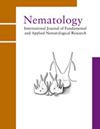从波斯毛茛(Ranunculus asiaticus L.)球茎中发现以色列二齿线虫(diylenchus israelensis n. sp.)(线虫纲:鳗科)
IF 1.2
4区 生物学
Q2 ZOOLOGY
引用次数: 0
摘要
本文报道了从以色列进口的波斯毛茛(Ranunculus asiaticus L.)球茎中分离到的一个新属。以色列双翅虫属(diylenchus israelensis n. sp.)是一两性生种;雌性有6个外侧切口,身体长而纤细,花柱纤细而短(7-8 μm),柄小而圆,在咽球基部前部有排泄孔,外阴位于后部(V = 78.6-83.1),脓液短(15.0-24.0 μm),尾长圆锥形,末端尖。雄性与雌性形态相似,针状体长14.0 ~ 18.0 μm。利用28S rDNA基因的18S、ITS和D2-D3扩增段对新种进行了分子表征。系统发育分析表明其在现有的双叶龙种中具有独立的地位,并与D. valveus有密切的系统发育亲缘关系。几种二叉蝇属受管制害虫;在给定样本中检测到它们可以实施检疫措施。然而,据我们所知,以色列剑齿虎对亚洲小茴香球茎没有造成任何损害。此外,未来关于繁殖能力和寄主关联的研究可能会对以色列家蝇的致病潜力有所帮助。本文章由计算机程序翻译,如有差异,请以英文原文为准。
Detection and description of Ditylenchus israelensis n. sp. (Nematoda: Anguinidae) from bulbs of the Persian buttercup (Ranunculus asiaticus L.)
The present study describes a new Ditylenchus species, isolated from the bulbs of the Persian buttercup (Ranunculus asiaticus L.) imported from Israel at the Ningbo plant quarantine lab, Ningbo, P.R. China. Ditylenchus israelensis n. sp. is an amphimictic species; females have six incisures in the lateral field, a long and slim body, a delicate, short stylet (7-8 μm) with small and rounded knobs, excretory pore in the anterior region of the basal pharyngeal bulb, posteriorly located vulva (V = 78.6-83.1), a short PUS (15.0-24.0 μm), and a long conical tail with a pointed terminus. Males are similar to females in general morphology and have 14.0-18.0 μm long spicules. The new species was also characterised molecularly using 18S, ITS and D2-D3 expansion segments of 28S rDNA genes. Our phylogenetic analyses showed its independent position among available Ditylenchus species and a close phylogenetic affinity with D. valveus. Several Ditylenchus species are regulated pests; their detection in a given sample can implement quarantine measures. However, to our knowledge D. israelensis n. sp. did not cause any damage to the R. asiaticus bulbs. In addition, future studies regarding fecundity and host association may shed some light on the pathogenic potential of D. israelensis n. sp.
求助全文
通过发布文献求助,成功后即可免费获取论文全文。
去求助
来源期刊

Nematology
生物-动物学
CiteScore
2.60
自引率
33.30%
发文量
67
审稿时长
3 months
期刊介绍:
Nematology is an international journal for the publication of all aspects of nematological research (with the exception of vertebrate parasitology), from molecular biology to field studies. Papers on nematode parasites of arthropods, and on soil free-living nematodes, and on interactions of these and other organisms, are particularly welcome. Research on fresh water and marine nematodes is also considered when the observations are of more general interest.
Nematology publishes full research papers, short communications, Forum articles (which permit an author to express a view on current or fundamental subjects), perspectives on nematology, and reviews of books and other media.
 求助内容:
求助内容: 应助结果提醒方式:
应助结果提醒方式:


